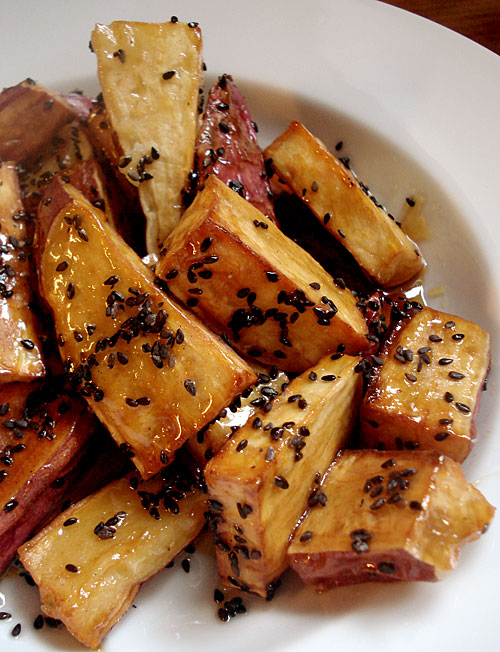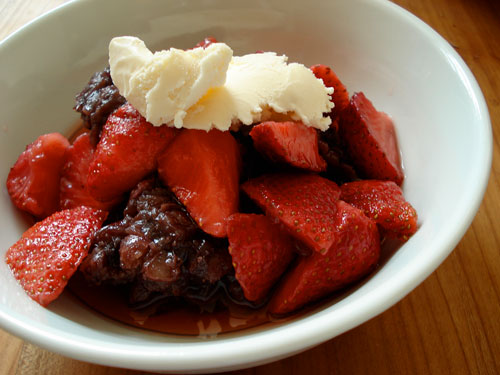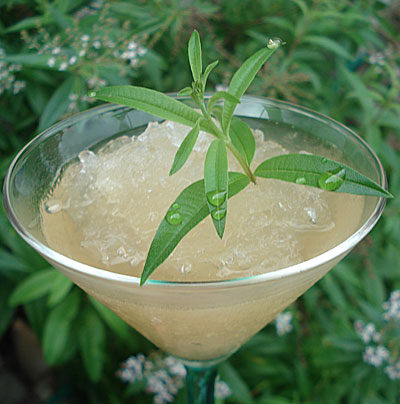From the archives. The very iffy photo shows that it is from the very early days of Just Hungry! I look back at this with nostalgia, because not only have my photography skills improved somewhat, it reflects a time in my life when I was into a far more complicated kind of cooking than I am now. I no longer bake things like this, but if you want a pretty spectacular chocolate dessert for Valentine's Day, and have the time and patience, I do highly recommend this rich yet feathery light little confection. I've edited it slightly to be more accurate (what the heck did I mean by 'small container of cream' anyhow). Originally published on February 13, 2004.

Filed under:
chocolate dessert baking cake

Since last year, there has been a craze for something called nama kyarameru (生キャラメル, raw caramel) in Japan. The demand has been so great that people form long lines to buy it, and at least at the beginning of the fad there were frequent reports of sell-outs and long waiting lists. Raw caramel means meltingly soft caramel candies that have been made with fresh milk, fresh butter, and no additives. It's been a great marketing ploy for some dairy farmers in Hokkaido.
Given that getting nama kyarameru from Hokkaido is not that easy for me, and believing firmly in the superiority of Swiss dairy products, I set about to make my own version. After many attempts, here is my version of raw caramel. They have a very slight fermented-sourness from the crème fraîche, and the pure salt flavor from the fleur de sel. And the sugar component is made richer by using golden syrup.
I have a feeling I will never buy caramel candies again.
Filed under:
dessert foodie gifts sweet favorites candy caramel

[From the archives. This very easy cake is especially nice at this time of year, when apples are in season. We don't actually eat this every day, but it's one of my go-to simple sweets to make. Originally published January 11, 2006.]
Filed under:
dessert fall baking quickbread cake favorites

In the fall, many universities throughout Japan have big festivals called 大学祭 daigaku-sai, meaning university festival, or 文化祭 bunnkasai, Culture Festival. They are basically street fairs held on campus, with lots of food and fun stalls, concerts, even ghost houses and amusement rides. Many of the big ones also hold concerts in which top Japanese singers and bands appear. Daigaku Imo, which means University Potato, are candies sweet potatoes, a sweet and slightly savory snack that is often served at university festivals in Tokyo.
The snack itself probably originated as a cheap, calorie-rich, affordable snack sold to cash-poor students around universities in Tokyo around the turn of the 20th century. The idea for deep frying and then sugar coating potatoes most likely came from similar snacks in Chinese cuisine.
Daigaku imo is simple to make, yet a bit tricky. You ideally want to coat the sweet potato slices completely with a hard caramel sugar coating, but too often the sugar gets crystallized. It doesn't taste bad when it does, but it looks far better with a shiny, smooth coating. I've found the best way to accomplish this is to make a fresh batch of the sugar coating for each batch of potatoes cooked. This is not diet food by any means, but regardless, to me they are one of the main treats of fall.
Filed under:
dessert japanese fall vegan gluten-free party snack
[From the archives: Today (September 23rd) is the first day of the fall o-higan (お彼岸), when ohagi or botamochi are offered to ones ancestors, as well as oneself! My mother and my grandmother always made these at home around this time of year - I love their not-too-sweet stickiness. O-higan ends on the 26th, so if you like wagashi, why not give these a try? Originally published March 2007.]
 The seven days centered around the bi-annual days of the vernal equinox is a Buddhist festival period known as higan (or o-higan for the honorific term) in Japan. The fall (autumn) higan is aki no higan, and the spring higan is haru no higan. Since the day of the spring equinox is March 21, we're about to enter the haru no ohigan period.
The seven days centered around the bi-annual days of the vernal equinox is a Buddhist festival period known as higan (or o-higan for the honorific term) in Japan. The fall (autumn) higan is aki no higan, and the spring higan is haru no higan. Since the day of the spring equinox is March 21, we're about to enter the haru no ohigan period.
During haru no higan, a sweet confection called botamochi is eaten. The mochi part means sticky, pounded rice, and the bota part comes from botan, or the tree peony. Botamochi is supposed to ressemble a tree peony flower.
During the autumn equinox (aki no higan or simply (o)higan)) period, a very similar confection called ohagi is eaten. This is supposed to look like a hagi or bush clover flower (Latin: Lespedeza thunbergii). Botamochi and o-hagi look the same to me, even though a hagi flower looks nothing like a tree peony flower, but the good old ancestors were probably a lot more imaginative than I am.
Botamochi and o-hagi are made of sticky rice and sweet tsubuan, 'chunky-style' sweet azuki bean paste. They are a bit fiddly to make but not difficult, especially if you use one of my favorite cooking helpers, plastic cling film. Since these are best eaten freshly made, it's well worth the effort to make them at home if you like bean-based Japanese sweets. You can adjust the amount of sugar in the tsubuan to your taste. Here I have made three variations: coated with black sesame seeds; coated with kinako (toasted soy bean powder); and the most traditional form with the rice cake wrapped in a layer of the tsubuan.
Filed under:
dessert japanese legumes rice vegetarian sweet vegan gluten-free wagashi

Just about anyone who takes a trip to the historical city of Kyoto goes home bearing a box of yatsuhashi (八つ橋), a small delicate sweet that is flavored with nikki or cinnamon. While I am not from Kyoto, I get a fit of nostalgia for yatsuhashi on occasion. Fortunately they aren't that hard to make at home. Added bonuses: they are more or less fat free, gluten-free, and vegan!

Filed under:
dessert japanese sweet tea vegan gluten-free wagashi

There are some food combinations that you think just shouldn't belong together, but do so well. Strawberries with sweet beans? Surely not, you think, until you taste an ichigo daifuku - a strawberry wrapped in some azuki an and thin gyuuhi, a dough made of rice. I've had ichigo daifuku on my mind lately but have been too lazy to make the dumplings. This is a very easy alternative. Arguably it's even better.
Filed under:
dessert japanese legumes summer vegan wagashi

I wrote about the use of kuzu powder in the _goma dofu_ (sesame tofu) recipe. This time it's a very traditional, simple sweet dish using kuzu.
Kuzumochi are sticky 'mochi' cakes made with just kuzu powder, sugar and water. The texture is somewhere in between gelatin and mochi made from rice flour - wobbly but not too sticky. It's traditionally served chilled, so it makes an interesting, gluten free (and vegan) summer dessert.
Filed under:
dessert japanese sweet summer vegan gluten-free wagashi

Even if I am Japanese, I don't like all Japanese food. And I must confess that I don't like a lot of traditional Japanese sweets that are based on sweetened beans. For the most part they are way too sweet for me, and if I make them for myself I'm always adjusting the sweetness level, as with my ohagi or botamochi.
Mitarashi dango, however, are my absolute favorite traditional sweet. They are not really that sweet really - that shiny caramel colored sauce (which is called mitarashi sauce) is sweet and savory at the same time. It goes perfectly with the bland, slightly chewy dango or dumplings. (Dango is the name for unfilled solid dumplings.)
You may see the dango just plained boiled more often than not. But grilling the dango makes them so much better, in my opinion.
Filed under:
dessert japanese party food wagashi

The lemon verbena plant that I planted last year and almost lost to a summer storm, is now firmly established and positively thriving. Whenever I pass it I can't resist rubbing a leaf, because it smells so wonderful.
Transferring that wonderful lemony scent to taste is quite easy - simply steeping it in some boiling water for about 10 to 15 minutes does the trick. This granita is infused with the aroma of lemon verbena, soured with a little lemon juice, and sweetened with a delicate acacia honey. Any light colored honey will work here instead. It makes a wonderful light dessert or palate cleanser, or cooling summer snack.
Filed under:
dessert lighter vegetarian sweet summer tea
Pages